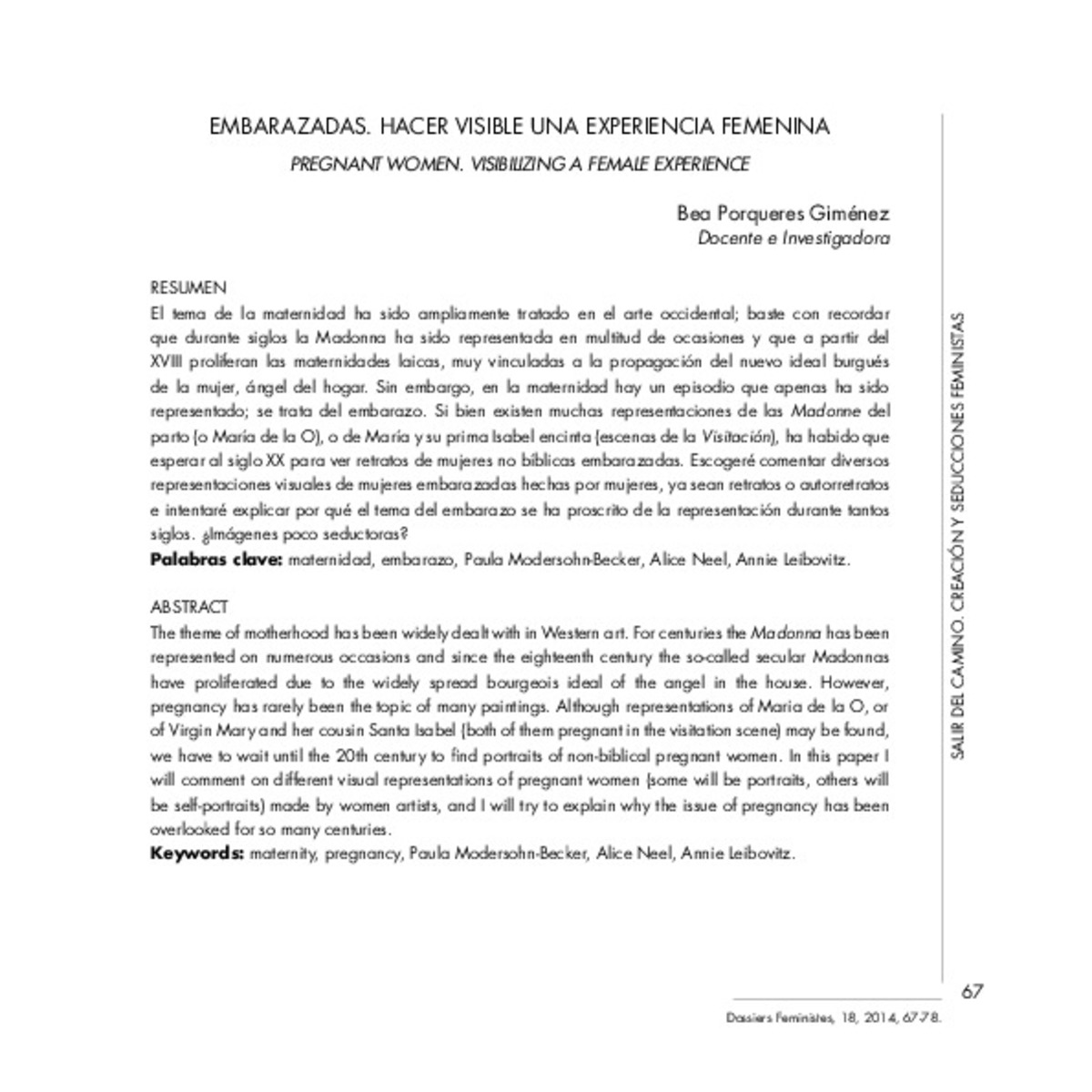Mostrar el registro sencillo del ítem
EMBARAZADAS. HACER VISIBLE UNA EXPERIENCIA FEMENINA
| dc.contributor.author | Porqueres Giménez, Bea | |
| dc.date.accessioned | 2015-11-27T08:54:19Z | |
| dc.date.available | 2015-11-27T08:54:19Z | |
| dc.date.issued | 2014 | |
| dc.identifier.issn | 1139-1219 | |
| dc.identifier.issn | 2340-4930 | |
| dc.identifier.uri | http://hdl.handle.net/10234/141609 | |
| dc.description.abstract | El tema de la maternidad ha sido ampliamente tratado en el arte occidental; baste con recordar que durante siglos la Madonna ha sido representada en multitud de ocasiones y que a partir del XVIII proliferan las maternidades laicas, muy vinculadas a la propagación del nuevo ideal burgués de la mujer, ángel del hogar. Sin embargo, en la maternidad hay un episodio que apenas ha sido representado; se trata del embarazo. Si bien existen muchas representaciones de las Madonne del parto (o María de la O), o de María y su prima Isabel encinta (escenas de la Visitación), ha habido que esperar al siglo XX para ver retratos de mujeres no bíblicas embarazadas. Escogeré comentar diversos representaciones visuales de mujeres embarazadas hechas por mujeres, ya sean retratos o autorretratos e intentaré explicar por qué el tema del embarazo se ha proscrito de la representación durante tantos siglos. ¿Imágenes poco seductoras? | ca_CA |
| dc.description.abstract | The theme of motherhood has been widely dealt with in Western art. For centuries the Madonna has been represented on numerous occasions and since the eighteenth century the so-called secular Madonnas have proliferated due to the widely spread bourgeois ideal of the angel in the house. However, pregnancy has rarely been the topic of many paintings. Although representations of Maria de la O, or of Virgin Mary and her cousin Santa Isabel (both of them pregnant in the visitation scene) may be found, we have to wait until the 20th century to find portraits of non-biblical pregnant women. In this paper I will comment on different visual representations of pregnant women (some will be portraits, others will be self-portraits) made by women artists, and I will try to explain why the issue of pregnancy has been overlooked for so many centuries | ca_CA |
| dc.format.mimetype | application/pdf | ca_CA |
| dc.language.iso | spa | ca_CA |
| dc.publisher | Universitat Jaume I. Institut Universitari d'Estudis Feministes i de Gènere | ca_CA |
| dc.relation.isPartOf | Dossiers Feministes, núm.18 | ca_CA |
| dc.rights.uri | http://rightsstatements.org/vocab/CNE/1.0/ | * |
| dc.subject | maternidad | ca_CA |
| dc.subject | embarazo | ca_CA |
| dc.subject | Paula Modersohn-Becker | ca_CA |
| dc.subject | Alice Neel | ca_CA |
| dc.subject | Annie Leibovitz | ca_CA |
| dc.subject | maternity | ca_CA |
| dc.subject | pregnancy | ca_CA |
| dc.subject | Paula Modersohn-Becker | ca_CA |
| dc.subject | Alice Neel | ca_CA |
| dc.subject | Annie Leibovitz | ca_CA |
| dc.subject.other | Dones -- Revistes | ca_CA |
| dc.subject.other | Feminisme -- Revistes | ca_CA |
| dc.title | EMBARAZADAS. HACER VISIBLE UNA EXPERIENCIA FEMENINA | ca_CA |
| dc.title.alternative | PREGNANT WOMEN. VISIBILIZING A FEMALE EXPERIENCE | ca_CA |
| dc.type | info:eu-repo/semantics/article | ca_CA |
| dc.rights.accessRights | info:eu-repo/semantics/openAccess | ca_CA |
| dc.relation.publisherVersion | http://www.e-revistes.uji.es/index.php/dossiers/article/view/1228/1246 | ca_CA |







